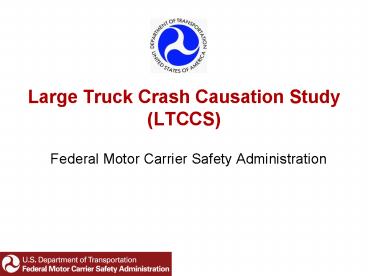Large Truck Crash Causation Study LTCCS - PowerPoint PPT Presentation
1 / 19
Title:
Large Truck Crash Causation Study LTCCS
Description:
Source: NHTSA (FARS for crash data); FHWA (Highway Statistics for VMT data) ... at 24 sites in 17 states by researchers from NHTSA and State truck inspectors. ... – PowerPoint PPT presentation
Number of Views:67
Avg rating:3.0/5.0
Title: Large Truck Crash Causation Study LTCCS
1
Large Truck Crash Causation Study (LTCCS)
- Federal Motor Carrier Safety Administration
2
Crash Statistics
- In 2004, large trucks accounted for 8 percent of
the vehicles in fatal crashes and only 3 percent
of the vehicles involved in injury. - In 2004, 4,440 fatal crashes involved a large
truck resulting in 5,190 fatalities. - 75 percent of these cases involved at least one
large truck and at least one passenger car.
3
Large Truck vs. Passenger Vehicle Fatality Rates
Source NHTSA (FARS for crash data) FHWA
(Highway Statistics for VMT data)
4
Large Truck vs. Passenger Vehicle Fatality
Injury Rates
Source NHTSA (FARS for crash data) FHWA
(Highway Statistics for VMT data)
5
Defining LTCCS Cause
LTCCS Cause - 1 a factors that increase the
risk of a crash such as driving behavior, vehicle
problems, road, and weather conditions b
something that does not usually result in a crash
but increases the chance of a crash
6
Study
- 963 large truck crashes resulting in at least one
fatality or injury investigated between April
2001 and December 2003 at 24 sites in 17 states
by researchers from NHTSA and State truck
inspectors. - LTTCS closely examined contributing factors.
- LTTCS database more useful for analyzing driver
and vehicle issues than highway design or
operation issues. - Not suited for evaluating factors that operate to
increase crash probabilities across all subsets
of crashes.
7
Primary Sampling Units
8
Ground Breaking Study
- Only nationally representative sample
- Largest number of crashes
- Largest number of data elements
- Researchers at crash scene
- Sound methodology
- Endorsed by Congress
9
Coding LTCCS Crashes
- Critical Event Event that immediately led to the
crash - Critical Reason for Critical Event Immediate
reason for critical event - Not the cause of the crash
- Crash Associated Factors All factors that could
be important
10
Crash Example
- Critical Event
- SUV turns left
- Critical Reason
- Driver inattention
- Associated Factors
11
Critical Events All Trucks
Events Number
- Over lane line or off road 25,000 32
- Lost control (speeding, etc.) 22,000 29
- Other vehicle in Lane 18,000 23
- Turning, crossing intersection 8,000 10
- Other (pedestrian, fire) 4,000 6
- Total 77,000 100
- C.E. not coded to truck 64,000
12
Critical Reason
- For two-vehicle crashes involving a truck and a
passenger vehicle, trucks were assigned the
critical reason in 44 percent of the cases and 56
percent for passenger vehicles. - Driver reasons accounted for the overwhelming
majority of the critical reasons 88 percent for
the trucks and 93 percent for passenger vehicles.
13
Critical Reasons for Crashes InvolvingOne Large
Truck and One Passenger Vehicle
93
88
8
4
4
3
Driver
Vehicle
Environment
Source Large Truck Crash Causation Study, 2005
14
LTCCS and Driver Factors
- Driver factors up to 10 times more prevalent than
vehicle or environmental factors in events that
led up to crashes involving one truck and one
passenger vehicle.
Critical Reason
15
Driver Issues
- Driver recognition and driver decision errors
were the most frequently cited critical reasons
for both types of vehicles. - Most common factors for both classes of drivers
Traveling too fast for conditions, making an
illegal maneuver, legal drug use, and
unfamiliarity with the roadway. - Fatigue (coded twice as often for the passenger
vehicle driver as for the truck driver)
16
Associated Factor Traveling too Fast for
Conditions
- Truck Drivers in all vehicle crashes 23
- Drivers in two-vehicle crashes
- Large-truck drivers 15
- Passenger-vehicle drivers 10
- Crashes of one large truck and one passenger
vehicle, or crashes of three or more vehicles in
which the first two vehicles that crash are a
large truck and a passenger vehicle.
17
Relative Risk Truck Driver Speeding, All Crashes
- Relative Risk Calculation
- (in thousands)
- 29 / (29 3) .91
- 48 / (48 60) .44
- .91 / .44 2.05
18
Relative Risk All Truck Drivers
Factor Number Risk Ratio
- Legal Drug Use 52,000 1.00
- Traffic Flow Interruption 40,000 .85
- Brake Problems 39,000 1.67
- Too Fast for Conditions 32,000 2.05
- Unfamiliar with Roadway 31,000 1.39
- Inadequate Surveillance 20,000 1.87
- Fatigue 19,000 1.82
- Distraction 14,000 1.64
19
Conclusion
- Crash Causation cannot be summed up by looking at
a single factor - LTCCS does not assign blame to any type of
vehicle over another type - Important Causation factors some old (speed,
fatigue, distraction, brakes, others), some new
(legal drugs, roadway unfamiliarity, others) - Study can help FMCSA focus programs
- More research needed on factors identified to
fully assess their impact































